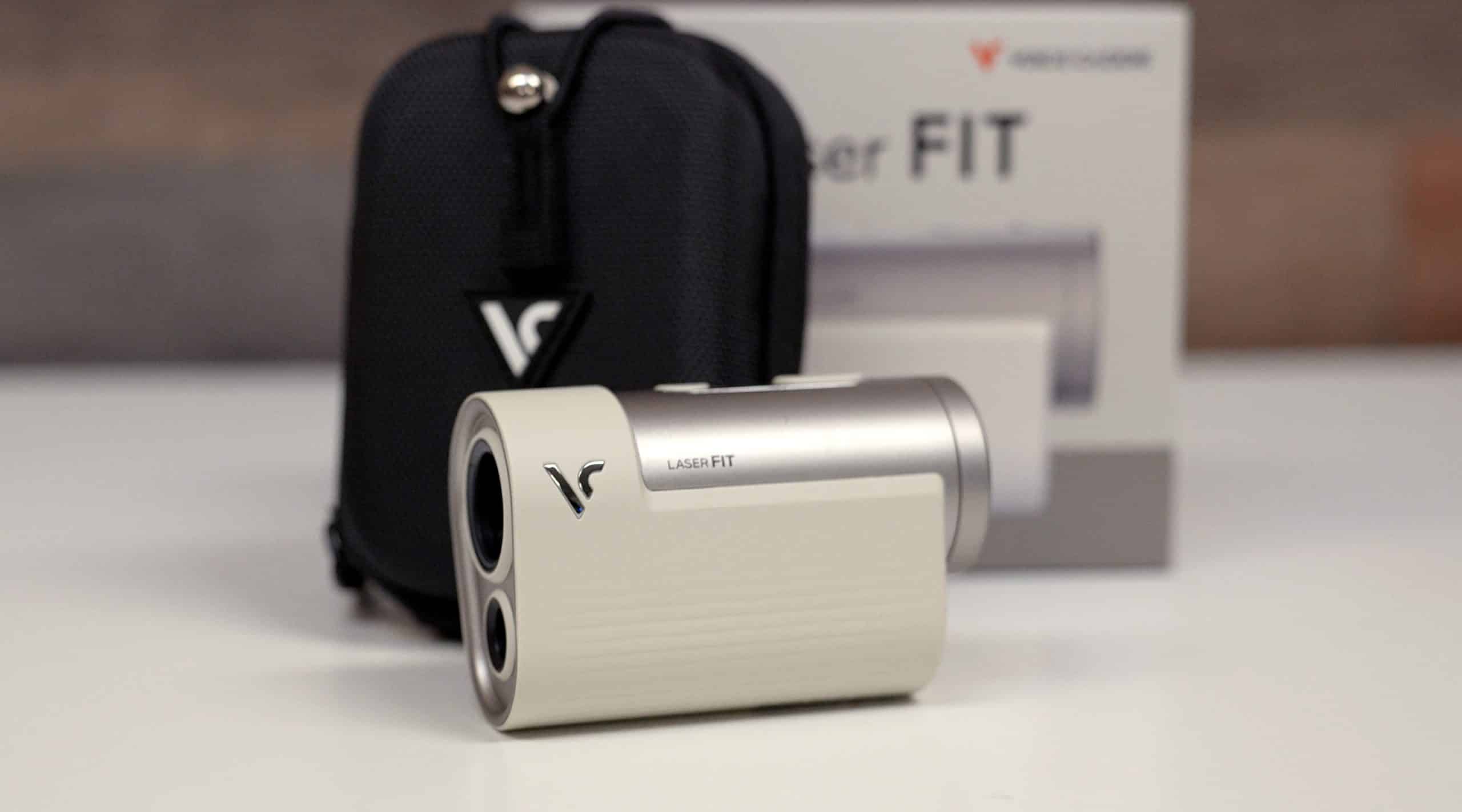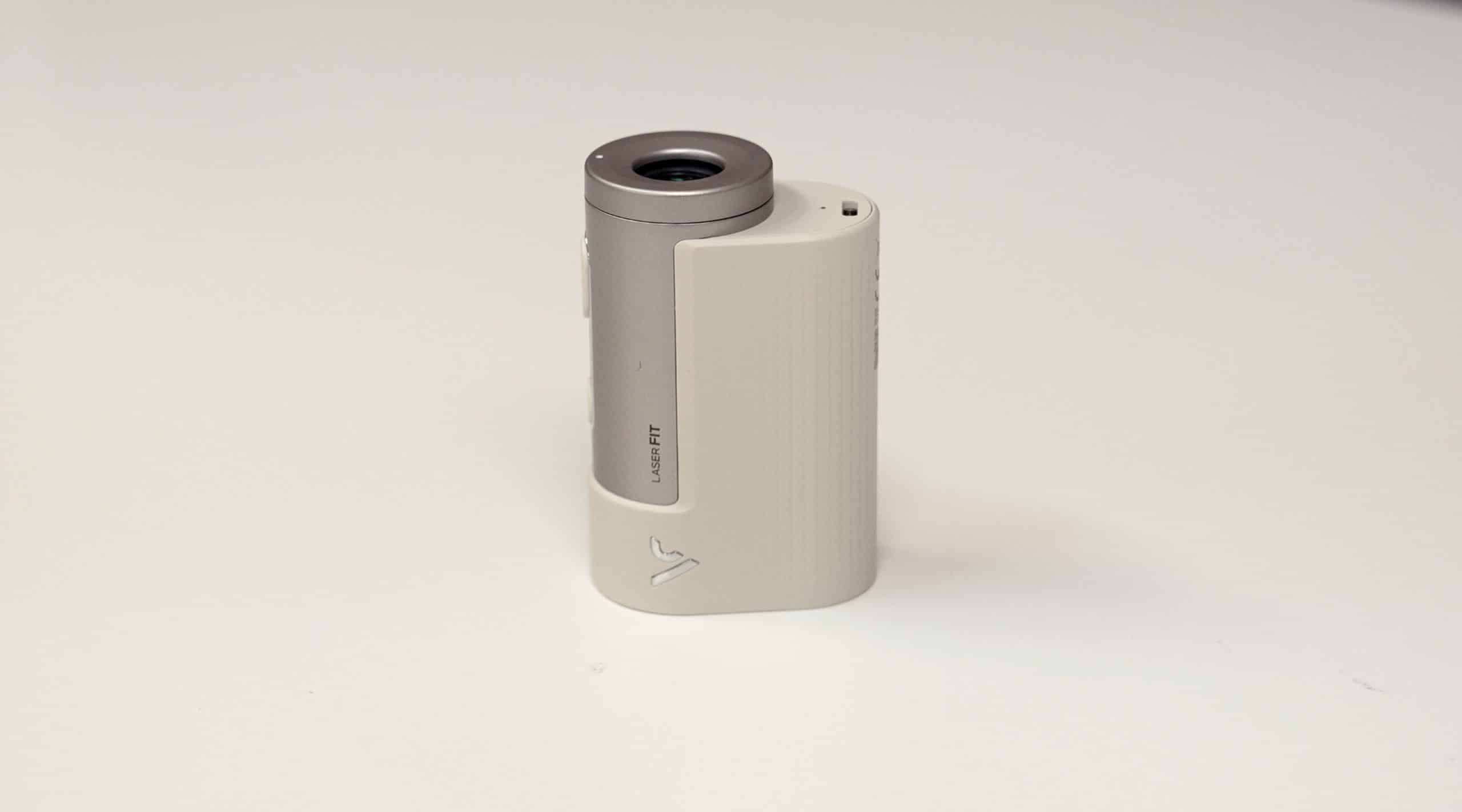When the Voice Caddie Laser Fit showed up at my door, I'll admit I was skeptical. At $199, this little rangefinder was claiming to go toe-to-toe with units costing twice as much. I've tested enough golf tech to know that bold claims rarely match reality. But as I pulled this compact device from its box, something felt different. The stainless steel accents caught the light just right, and that leather wrap? It felt like someone actually thought about how this thing would feel in my hand after 18 holes.
Here's what struck me immediately: this thing is tiny. We're talking 4 ounces – lighter than my wallet after a bad round at the 19th hole. I could literally forget it was in my pocket. The red and black color scheme won't win any fashion awards, but there's something purposeful about it. It looks like it means business without trying too hard. The Metal Beige colorway I tested has a sophisticated look that stands out from the typical all-black rangefinder crowd.
I've used rangefinders that make you feel like you're playing Where's Waldo with the flagstick. You know the drill – you're aiming, re-aiming, cursing under your breath while your playing partners tap their feet. The Laser Fit's Pin Tracer technology changed that equation for me, and I need to explain why this matters more than you might think. Voice Caddie markets this as their best-in-class optics system, and after extensive testing, I'm inclined to agree with that bold claim.
The system fundamentally creates an invisible net around the pin. Instead of needing surgeon-steady hands to lock onto that thin flagstick, you can sweep across the general area and the device grabs it automatically. During testing at my home course (where the back nine pins seem to disappear into the horizon), I was consistently locking on within 2-3 seconds. That's not marketing speak – I actually timed it.
What really sold me was how it handled those awkward pin positions. You know the ones – tucked behind a bunker lip or situated against trees. The expanded detection zone meant I wasn't fighting the device. It found the pin while I was still scanning, giving me that satisfying vibration feedback that says "got it." The display shows you the distance clearly, and here's the kicker: it holds that reading for a beat even after you lower the device, so you're not scrambling to remember the number.
But let's be real – it's not magic. On extremely bright days with heat shimmer coming off the fairway, I occasionally had to make a second pass. And at distances over 250 yards, that lock-on becomes less instantaneous. Still, compared to my old rangefinder that required the steady hands of a neurosurgeon? This felt like cheating.

This feature alone might justify the purchase price, especially if you play courses with those dreaded "cart path only" days. I realized its true value during a wet spring round when we couldn't take carts on the fairway. Instead of hiking to my ball with my rangefinder, checking the distance, then hiking back to grab the right club, I could shoot both distances from wherever I stood.
The execution is brilliantly simple. One button press gives you the distance to your ball. Press again, and you get the pin distance. The device remembers both numbers and displays them simultaneously. During a round at an unfamiliar course last month, this saved me from multiple measurement mistakes. I was standing near the cart path, about 30 yards from my ball in the rough. Old me would have guessed the distance to my ball, grabbed a club, then realized I was off by 15 yards. With Ball to Pin, I knew I had 35 yards to my ball and 165 to the pin – meaning I needed 130 yards of carry once I reached my ball.
The feature really shines on dogleg holes where you can't see the pin from your ball position. Shoot both distances from an angle where you can see everything, and you've got your complete scene. I found myself using it constantly for approach shots, especially when helping playing partners who didn't have rangefinders. "You're 45 to your ball, 180 to the pin" became my most repeated phrase. The triangulation feature proves particularly valuable for cart golfers who need to plan shots from distances away from their ball.
There's a learning curve to maximizing this feature. You need to think strategically about where to take your measurements. But once it clicks? You'll wonder how you ever played without it.
Every rangefinder seems to have slope these days, but Voice Caddie did something clever here that deserves attention. Yes, it calculates elevation-adjusted distances (and does it well), but the implementation is what sets it apart. The slope readings appear as a separate number below your standard distance, along with the actual degree of slope. So you might see 150 yards standard, 162 adjusted, +8° slope.
Why does seeing the actual slope degree matter? Because it taught me something about my game I didn't realize. I uncovered I consistently under-club on anything over 5 degrees of upslope and over-club on downslopes steeper than -7 degrees. That's information you can't get from just an adjusted yardage. Now I know that a +10° slope means I need to think two clubs up, not just trust the adjusted distance blindly.
The tournament mode switch is external and obvious – a physical toggle that shows red when slope is on, white when it's off. No menu diving, no wondering if you accidentally left slope on during your club championship. I've seen guys DQ'd for having slope on during tournaments (honest mistakes, but still), and this design choice eliminates that worry. The switch has a satisfying click to it, too. You know exactly what mode you're in.
Here's something the marketing materials don't emphasize enough: the V-Algorithm they use for slope calculation factors in typical ball flight patterns. It's not just simple trigonometry. During testing, I compared it against my playing partner's Bushnell Pro X3, and the readings were within 1-2 yards consistently. For a device at this price point, that's extraordinary accuracy.

I've always been a "black display is fine" guy. Then I played an early morning round with the sun coming up directly behind the pin, and suddenly I understood why Voice Caddie included a dual-color display. The LED inside the viewfinder switches between black and red, and it's not automatic – you control it based on what you need.
Black works great against bright skies and most backgrounds. But when you're shooting toward shadows, heavy trees, or in that weird twilight lighting, red becomes your best friend. The contrast just pops in a way that makes the numbers impossible to miss. I found myself switching more than expected, especially on tree-lined courses where the background constantly changes.
The three brightness levels seem like overkill until you actually need them. Brightest setting for sunny days, medium for overcast, and dim for those dawn patrol rounds. The display clarity itself is good, not great. You're not getting the crystal-clear optics of a $500 rangefinder, but for the price? It's more than adequate. Numbers are large and legible, and the reticle doesn't obstruct your view of the target.
One quirk: the display timeout is pretty aggressive to save battery. If you're someone who likes to range multiple targets then think about it for 30 seconds, you'll be pressing buttons again. Minor annoyance, but worth mentioning.
Let's address what every review seems to dance around: yes, it feels a bit plasticky compared to premium rangefinders. There, I said it. The body is primarily plastic with those stainless steel accents I mentioned. But here's my take after three months of regular use – who cares?
This thing has lived in my golf bag, been dropped on cart paths (twice), gotten rained on, and accidentally went through a ball washer incident we don't need to discuss. It still works perfectly. The leather wrap has developed a nice patina that actually looks better than new. The lens covers (magnetic attachment, by the way) have stayed secure without any issues.
The rechargeable battery deserves its own praise. I charged it when I first got it, played 12 rounds over six weeks, and it's still showing 60% battery. The USB-C charging is modern and convenient – same cable as my phone. No hunting for proprietary chargers or buying CR2 batteries at inflated pro shop prices.
The form factor is the real win here. At 3.39" x 1.48" x 2.21", it disappears in your pocket. I've played entire rounds forgetting it was there until I needed it. Compare that to some premium models that feel like carrying a small telescope, and the trade-off becomes clear. Would I prefer a full metal body? Sure. Does the current build impact performance or longevity? Not from what I've seen.
Yes, you can use the Voice Caddie Laser FIT in tournament play when you turn off its slope mode. The device has a tournament mode that disables slope readings, making it compliant with USGA and R&A rules. You'll find it easy to toggle between slope and tournament modes, ensuring you won't accidentally violate competition rules. Just remember to check your specific tournament's regulations, as some events may have additional restrictions on rangefinder use.
You'll get a one-year limited warranty with your Voice Caddie Laser Fit, starting from your original purchase date. This warranty covers defects in materials and workmanship for the rangefinder device itself. You'll need to keep your proof of purchase for any warranty claims. Be aware that normal wear and tear, battery issues, and accessories aren't covered under this warranty. The one-year coverage is standard for golf rangefinders in this price range.
Your Voice Caddie Laser Fit is water-resistant, not waterproof. It'll handle light rain and morning dew during your rounds, but you shouldn't expose it to heavy rain or submerge it in water. The device doesn't have an official IP rating, and some users report it's less water-resistant than other rangefinders. You'll want to keep it dry when possible and store it properly during severe weather to prevent internal damage.
You'll get approximately 8 hours of actual use from a single charge of the 500mAh lithium-polymer battery. That's enough for about 40+ rounds of golf since you're only using the rangefinder intermittently during play - typically 10-15 minutes total per round. The rechargeable battery eliminates the need to buy replacements, though you'll need to remember to charge it via the included USB-C cable between sessions.
Yes, you'll find the Laser Fit works with prescription glasses and sunglasses. The ocular lens accommodates standard corrective eyewear, though you might need slight eye positioning adjustments for ideal viewing. The dual-color LED display with three brightness levels helps maintain visibility through tinted lenses. However, heavily polarized or dark sunglasses can occasionally interfere with target acquisition, so you may need to briefly remove them if you're experiencing difficulty locking onto targets.
The Voice Caddie Laser Fit occupies a sweet spot in the rangefinder market that I didn't know existed. It's not trying to be a Bushnell Pro X3 or a Garmin Z82. It's something different – a rangefinder for the golfer who wants modern features without the premium price tag or the bulk.
Who's it for? If you're someone who plays 20-40 rounds a year, wants slope functionality for practice rounds, and values portability over premium optics, this is your rangefinder. It's also perfect for anyone who regularly deals with cart path restrictions – that Ball to Pin mode will change how you play those rounds. However, if you're a low handicapper who demands the absolute best optics and build quality, or if you're someone who just likes owning the premium version of everything, spend the extra money on a flagship model. You'll sleep better knowing you have the "best," even if this does 95% of the same job for half the price.